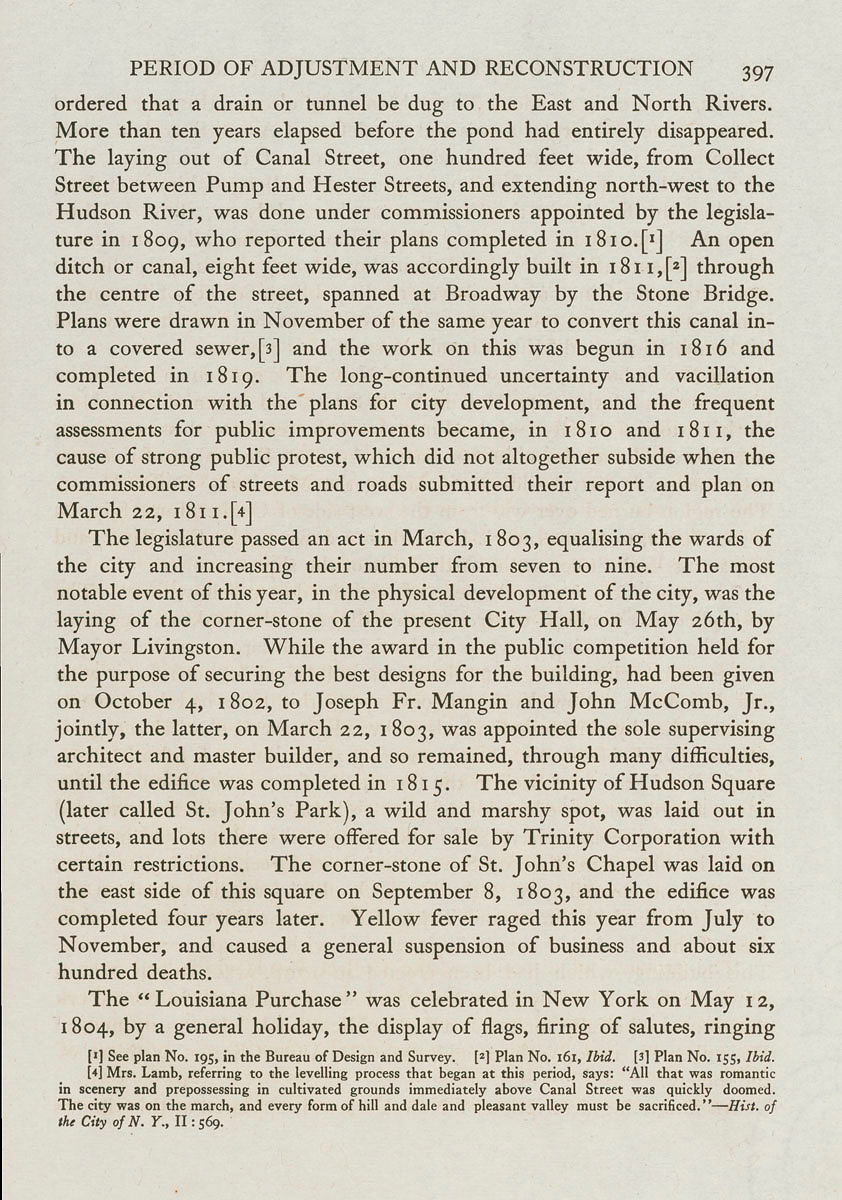PERIOD OF ADJUSTMENT AND RECONSTRUCTION 397
ordered that a drain or tunnel be dug to the East and North Rivers.
More than ten years elapsed before the pond had entirely disappeared.
The laying out of Canal Street, one hundred feet wide, from Collect
Street between Pump and Hester Streets, and extending north-west to the
Hudson River, was done under commissioners appointed by the legisla¬
ture in 1809, who reported their plans completed in i8io.[»] An open
ditch or canal, eight feet wide, was accordingly built in 1811, [2] through
the centre of the street, spanned at Broadway by the Stone Bridge.
Plans were drawn in November of the same year to convert this canal in¬
to a covered sewer, [3] and the work on this was begun in 1816 and
completed in 1819. The long-continued uncertainty and vacillation
in connection with the plans for city development, and the frequent
assessments for public improvements became, in i 81 o and i 811, the
cause of strong public protest, which did not altogether subside when the
commissioners of streets and roads submitted their report and plan on
March 22, i8ii.[4]
The legislature passed an act in March, 1803, equalising the wards of
the city and increasing their number from seven to nine. The most
notable event of this year, in the physical development of the city, was the
laying of the corner-stone of the present City Hall, on May 26th, by
Mayor Livingston. While the award in the public competition held for
the purpose of securing the best designs for the building, had been given
on October 4, 1802, to Joseph Fr. Mangin and John McComb, Jr.,
jointly, the latter, on March 22, 1803, was appointed the sole supervising
architect and master builder, and so remained, through many difficulties,
until the edifice was completed in 1815. The vicinity of Hudson Square
(later called St. John's Park), a wild and marshy spot, was laid out in
streets, and lots there were offered for sale by Trinity Corporation with
certain restrictions. The corner-stone of St. John's Chapel was laid on
the east side of this square on September 8, 1803, and the edifice was
completed four years later. Yellow fever raged this year from July to
November, and caused a general suspension of business and about six
hundred deaths.
The " Louisiana Purchase " was celebrated in New York on May 12,
1804, by a general holiday, the display of flags, firing of salutes, ringing
[i] See plan No. 195, in the Bureau of Design and Survey. [2] Plan No. 161, Ibid, [i] Plan No. 155, Ibid.
[4] Mrs. Lamb, referring to the levelling process that began at this period, says: "All that was romantic
in scenery and prepossessing in cultivated grounds immediately above Canal Street was quickly doomed.
The city was on the march, and every form of hill and dale and pleasant valley must be sacrificed."—Hist, of
the City of N. Y., 11:569.
|








